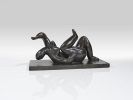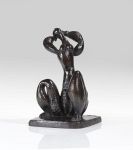
Jankel Adler
Tuszyn
1895 -
Aldbourne/ London
1949
Jankiel Adler was born on 26th July, 1895 in Tuszyn. His parents only called him Jankel, a name he later used himself. He grew up among hassic Jews surrounding the textile city of Lodz, influenced greatly by its Polish, German and Jewish population.
Adler started an apprenticeship as an engraver with his uncle in Belgrade in 1912, after which he traveled through the Balkan countries. During World War I, as a "suspicious foreigner" Adler commenced his studies with Professor Gustav Wiethüchter at the "Kunstgewerbeschule" in Barmen, Germany.
After his studies he spent time in Poland, Berlin and Paris. In 1922, Jankel Adler moved to Düsseldorf, where he taught at the art academy together with Paul Klee, who started teaching there in 1930. Both artists belonged to a group called "Junges Rheinland". In 1931 Adler moved into a studio at the Düsseldorf academy, which he abandoned in 1933 when leaving Germany upon friends' advice, after he had published together with other left-wing artists and intellectuals an "urgent appeal" against the Nazi policy and for communism during the campaigns for the parliamentary elections in February 1933.
At first, Adler escaped to Paris and took his exile as conscious fight against the fascist regime in Germany. When World War II broke out in 1939, Jankel Adler volunteered for the Polish army. Two years later, however, he was dismissed due to his bad health. Jankel Adler moved to Scotland and shortly after to London. During the 1940s a number of respectable exhibitions of Adler's works took place in London, Paris and New York. Throughout his life Jankel Adler's figures remained influenced by the styles of Picasso and Leger. He often used mixing techniques, unlike Picasso and Leger, he applied colors very pastily, leaving the surface of the paintings sgrafitto-like.
In 1949 Jankel Adler died in Albourne near London.
Would you like to sell a work by Jankel Adler?
Infos for seller




